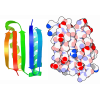[English] 日本語
 Yorodumi
Yorodumi- PDB-6xhb: Crystal Structure of wild-type KRAS (GMPPNP-bound) in complex wit... -
+ Open data
Open data
- Basic information
Basic information
| Entry | Database: PDB / ID: 6xhb | ||||||
|---|---|---|---|---|---|---|---|
| Title | Crystal Structure of wild-type KRAS (GMPPNP-bound) in complex with RAS-binding domain (RBD) and cysteine-rich domain (CRD) of RAF1/CRAF (crystal form II) | ||||||
 Components Components |
| ||||||
 Keywords Keywords | ONCOPROTEIN/Transferase /  KRAS / RAS / KRAS / RAS /  K-ras / KRAS4b / K-ras / KRAS4b /  RAF1 / CRAF / RBD / RAS-binding domain / cysteine-rich domain / CRD / RAF1 / CRAF / RBD / RAS-binding domain / cysteine-rich domain / CRD /  ONCOPROTEIN / ONCOPROTEIN-Transferase complex ONCOPROTEIN / ONCOPROTEIN-Transferase complex | ||||||
| Function / homology |  Function and homology information Function and homology information death-inducing signaling complex assembly / intermediate filament cytoskeleton organization / type B pancreatic cell proliferation / regulation of Rho protein signal transduction / SHOC2 M1731 mutant abolishes MRAS complex function / Gain-of-function MRAS complexes activate RAF signaling / Rap1 signalling / death-inducing signaling complex assembly / intermediate filament cytoskeleton organization / type B pancreatic cell proliferation / regulation of Rho protein signal transduction / SHOC2 M1731 mutant abolishes MRAS complex function / Gain-of-function MRAS complexes activate RAF signaling / Rap1 signalling /  regulation of cell motility / insulin secretion involved in cellular response to glucose stimulus / forebrain astrocyte development ... regulation of cell motility / insulin secretion involved in cellular response to glucose stimulus / forebrain astrocyte development ... death-inducing signaling complex assembly / intermediate filament cytoskeleton organization / type B pancreatic cell proliferation / regulation of Rho protein signal transduction / SHOC2 M1731 mutant abolishes MRAS complex function / Gain-of-function MRAS complexes activate RAF signaling / Rap1 signalling / death-inducing signaling complex assembly / intermediate filament cytoskeleton organization / type B pancreatic cell proliferation / regulation of Rho protein signal transduction / SHOC2 M1731 mutant abolishes MRAS complex function / Gain-of-function MRAS complexes activate RAF signaling / Rap1 signalling /  regulation of cell motility / insulin secretion involved in cellular response to glucose stimulus / forebrain astrocyte development / Negative feedback regulation of MAPK pathway / regulation of cell motility / insulin secretion involved in cellular response to glucose stimulus / forebrain astrocyte development / Negative feedback regulation of MAPK pathway /  regulation of synaptic transmission, GABAergic / negative regulation of epithelial cell differentiation / epithelial tube branching involved in lung morphogenesis / type I pneumocyte differentiation / IFNG signaling activates MAPKs / GP1b-IX-V activation signalling / ERBB2-ERBB3 signaling pathway / Rac protein signal transduction / regulation of synaptic transmission, GABAergic / negative regulation of epithelial cell differentiation / epithelial tube branching involved in lung morphogenesis / type I pneumocyte differentiation / IFNG signaling activates MAPKs / GP1b-IX-V activation signalling / ERBB2-ERBB3 signaling pathway / Rac protein signal transduction /  regulation of cell differentiation / face development / skeletal muscle cell differentiation / regulation of cell differentiation / face development / skeletal muscle cell differentiation /  pseudopodium / positive regulation of Rac protein signal transduction / somatic stem cell population maintenance / Signaling by RAS GAP mutants / Signaling by RAS GTPase mutants / Activation of RAS in B cells / neurotrophin TRK receptor signaling pathway / thyroid gland development / RAS signaling downstream of NF1 loss-of-function variants / RUNX3 regulates p14-ARF / SOS-mediated signalling / Activated NTRK3 signals through RAS / Activated NTRK2 signals through RAS / extrinsic apoptotic signaling pathway via death domain receptors / pseudopodium / positive regulation of Rac protein signal transduction / somatic stem cell population maintenance / Signaling by RAS GAP mutants / Signaling by RAS GTPase mutants / Activation of RAS in B cells / neurotrophin TRK receptor signaling pathway / thyroid gland development / RAS signaling downstream of NF1 loss-of-function variants / RUNX3 regulates p14-ARF / SOS-mediated signalling / Activated NTRK3 signals through RAS / Activated NTRK2 signals through RAS / extrinsic apoptotic signaling pathway via death domain receptors /  MAP kinase kinase kinase activity / SHC1 events in ERBB4 signaling / Signalling to RAS / glial cell proliferation / SHC-related events triggered by IGF1R / Activated NTRK2 signals through FRS2 and FRS3 / negative regulation of protein-containing complex assembly / Estrogen-stimulated signaling through PRKCZ / SHC-mediated cascade:FGFR3 / MET activates RAS signaling / PTK6 Regulates RHO GTPases, RAS GTPase and MAP kinases / Schwann cell development / Signaling by PDGFRA transmembrane, juxtamembrane and kinase domain mutants / Signaling by PDGFRA extracellular domain mutants / SHC-mediated cascade:FGFR2 / type II interferon-mediated signaling pathway / SHC-mediated cascade:FGFR4 / Signaling by FGFR4 in disease / SHC-mediated cascade:FGFR1 / Erythropoietin activates RAS / homeostasis of number of cells within a tissue / protein-membrane adaptor activity / negative regulation of extrinsic apoptotic signaling pathway via death domain receptors / positive regulation of glial cell proliferation / FRS-mediated FGFR3 signaling / Signaling by CSF3 (G-CSF) / Signaling by FLT3 ITD and TKD mutants / FRS-mediated FGFR2 signaling / FRS-mediated FGFR4 signaling / Signaling by FGFR3 in disease / p38MAPK events / FRS-mediated FGFR1 signaling / Tie2 Signaling / Signaling by FGFR2 in disease / striated muscle cell differentiation / GRB2 events in EGFR signaling / SHC1 events in EGFR signaling / activation of adenylate cyclase activity / EGFR Transactivation by Gastrin / response to muscle stretch / MAP kinase kinase kinase activity / SHC1 events in ERBB4 signaling / Signalling to RAS / glial cell proliferation / SHC-related events triggered by IGF1R / Activated NTRK2 signals through FRS2 and FRS3 / negative regulation of protein-containing complex assembly / Estrogen-stimulated signaling through PRKCZ / SHC-mediated cascade:FGFR3 / MET activates RAS signaling / PTK6 Regulates RHO GTPases, RAS GTPase and MAP kinases / Schwann cell development / Signaling by PDGFRA transmembrane, juxtamembrane and kinase domain mutants / Signaling by PDGFRA extracellular domain mutants / SHC-mediated cascade:FGFR2 / type II interferon-mediated signaling pathway / SHC-mediated cascade:FGFR4 / Signaling by FGFR4 in disease / SHC-mediated cascade:FGFR1 / Erythropoietin activates RAS / homeostasis of number of cells within a tissue / protein-membrane adaptor activity / negative regulation of extrinsic apoptotic signaling pathway via death domain receptors / positive regulation of glial cell proliferation / FRS-mediated FGFR3 signaling / Signaling by CSF3 (G-CSF) / Signaling by FLT3 ITD and TKD mutants / FRS-mediated FGFR2 signaling / FRS-mediated FGFR4 signaling / Signaling by FGFR3 in disease / p38MAPK events / FRS-mediated FGFR1 signaling / Tie2 Signaling / Signaling by FGFR2 in disease / striated muscle cell differentiation / GRB2 events in EGFR signaling / SHC1 events in EGFR signaling / activation of adenylate cyclase activity / EGFR Transactivation by Gastrin / response to muscle stretch /  myelination / Signaling by FLT3 fusion proteins / FLT3 Signaling / Ras activation upon Ca2+ influx through NMDA receptor / GRB2 events in ERBB2 signaling / Signaling by FGFR1 in disease / NCAM signaling for neurite out-growth / CD209 (DC-SIGN) signaling / SHC1 events in ERBB2 signaling / Downstream signal transduction / Constitutive Signaling by Overexpressed ERBB2 / Insulin receptor signalling cascade / myelination / Signaling by FLT3 fusion proteins / FLT3 Signaling / Ras activation upon Ca2+ influx through NMDA receptor / GRB2 events in ERBB2 signaling / Signaling by FGFR1 in disease / NCAM signaling for neurite out-growth / CD209 (DC-SIGN) signaling / SHC1 events in ERBB2 signaling / Downstream signal transduction / Constitutive Signaling by Overexpressed ERBB2 / Insulin receptor signalling cascade /  small monomeric GTPase / insulin-like growth factor receptor signaling pathway / G protein activity / Signaling by phosphorylated juxtamembrane, extracellular and kinase domain KIT mutants / thymus development / VEGFR2 mediated cell proliferation / FCERI mediated MAPK activation / Signaling by ERBB2 TMD/JMD mutants / regulation of long-term neuronal synaptic plasticity / RAF activation / Signaling by high-kinase activity BRAF mutants / Constitutive Signaling by EGFRvIII small monomeric GTPase / insulin-like growth factor receptor signaling pathway / G protein activity / Signaling by phosphorylated juxtamembrane, extracellular and kinase domain KIT mutants / thymus development / VEGFR2 mediated cell proliferation / FCERI mediated MAPK activation / Signaling by ERBB2 TMD/JMD mutants / regulation of long-term neuronal synaptic plasticity / RAF activation / Signaling by high-kinase activity BRAF mutants / Constitutive Signaling by EGFRvIIISimilarity search - Function | ||||||
| Biological species |   Homo sapiens (human) Homo sapiens (human) | ||||||
| Method |  X-RAY DIFFRACTION / X-RAY DIFFRACTION /  SYNCHROTRON / SYNCHROTRON /  MOLECULAR REPLACEMENT / Resolution: 2.5 Å MOLECULAR REPLACEMENT / Resolution: 2.5 Å | ||||||
 Authors Authors | Tran, T.H. / Chan, A.H. / Dharmaiah, S. / Simanshu, D.K. | ||||||
| Funding support |  United States, 1items United States, 1items
| ||||||
 Citation Citation |  Journal: Nat Commun / Year: 2021 Journal: Nat Commun / Year: 2021Title: KRAS interaction with RAF1 RAS-binding domain and cysteine-rich domain provides insights into RAS-mediated RAF activation. Authors: Tran, T.H. / Chan, A.H. / Young, L.C. / Bindu, L. / Neale, C. / Messing, S. / Dharmaiah, S. / Taylor, T. / Denson, J.P. / Esposito, D. / Nissley, D.V. / Stephen, A.G. / McCormick, F. / Simanshu, D.K. | ||||||
| History |
|
- Structure visualization
Structure visualization
| Structure viewer | Molecule:  Molmil Molmil Jmol/JSmol Jmol/JSmol |
|---|
- Downloads & links
Downloads & links
- Download
Download
| PDBx/mmCIF format |  6xhb.cif.gz 6xhb.cif.gz | 149.6 KB | Display |  PDBx/mmCIF format PDBx/mmCIF format |
|---|---|---|---|---|
| PDB format |  pdb6xhb.ent.gz pdb6xhb.ent.gz | 114.5 KB | Display |  PDB format PDB format |
| PDBx/mmJSON format |  6xhb.json.gz 6xhb.json.gz | Tree view |  PDBx/mmJSON format PDBx/mmJSON format | |
| Others |  Other downloads Other downloads |
-Validation report
| Arichive directory |  https://data.pdbj.org/pub/pdb/validation_reports/xh/6xhb https://data.pdbj.org/pub/pdb/validation_reports/xh/6xhb ftp://data.pdbj.org/pub/pdb/validation_reports/xh/6xhb ftp://data.pdbj.org/pub/pdb/validation_reports/xh/6xhb | HTTPS FTP |
|---|
-Related structure data
| Related structure data | 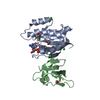 6vjjSC  6xguC 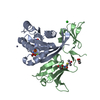 6xgvC 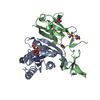 6xhaC 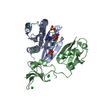 6xi7C 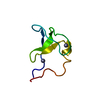 1farS S: Starting model for refinement C: citing same article ( |
|---|---|
| Similar structure data |
- Links
Links
- Assembly
Assembly
| Deposited unit | 
| ||||||||
|---|---|---|---|---|---|---|---|---|---|
| 1 |
| ||||||||
| Unit cell |
| ||||||||
| Components on special symmetry positions |
|
- Components
Components
-Protein , 2 types, 2 molecules AB
| #1: Protein | Mass: 19328.811 Da / Num. of mol.: 1 Source method: isolated from a genetically manipulated source Source: (gene. exp.)   Homo sapiens (human) / Gene: KRAS, KRAS2, RASK2 / Production host: Homo sapiens (human) / Gene: KRAS, KRAS2, RASK2 / Production host:   Escherichia coli (E. coli) / References: UniProt: P01116 Escherichia coli (E. coli) / References: UniProt: P01116 |
|---|---|
| #2: Protein | Mass: 15888.440 Da / Num. of mol.: 1 Source method: isolated from a genetically manipulated source Source: (gene. exp.)   Homo sapiens (human) / Gene: RAF1, RAF / Production host: Homo sapiens (human) / Gene: RAF1, RAF / Production host:   Escherichia coli (E. coli) Escherichia coli (E. coli)References: UniProt: P04049,  non-specific serine/threonine protein kinase non-specific serine/threonine protein kinase |
-Non-polymers , 7 types, 97 molecules 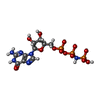



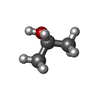








| #3: Chemical | ChemComp-GNP /  5'-Guanylyl imidodiphosphate 5'-Guanylyl imidodiphosphate | ||||||||
|---|---|---|---|---|---|---|---|---|---|
| #4: Chemical | ChemComp-MG / | ||||||||
| #5: Chemical |  Chloride Chloride#6: Chemical |  Glycerol Glycerol#7: Chemical | ChemComp-IPA / |  Isopropyl alcohol Isopropyl alcohol#8: Chemical | #9: Water | ChemComp-HOH / |  Water Water |
-Details
| Has ligand of interest | Y |
|---|
-Experimental details
-Experiment
| Experiment | Method:  X-RAY DIFFRACTION / Number of used crystals: 1 X-RAY DIFFRACTION / Number of used crystals: 1 |
|---|
- Sample preparation
Sample preparation
| Crystal | Density Matthews: 3.27 Å3/Da / Density % sol: 62.44 % |
|---|---|
Crystal grow | Temperature: 293 K / Method: vapor diffusion, sitting drop / pH: 6.5 Details: 100 mM sodium cacodylate pH 6.5, 200 mM sodium citrate, 15% 2-propanol, 0.25% (w/v) n-octyl-beta-D-glucoside, 0.35 mM D-myo-phosphatidylinositol 3,4,5-triphosphate, and 0.25% (w/v) n-dodecyl-beta-D-maltoside |
-Data collection
| Diffraction | Mean temperature: 100 K / Serial crystal experiment: N | ||||||||||||||||||||||||||||||||||||||||||||||||||||||||||||||||||||||||||||||||||||||||||||||||||||
|---|---|---|---|---|---|---|---|---|---|---|---|---|---|---|---|---|---|---|---|---|---|---|---|---|---|---|---|---|---|---|---|---|---|---|---|---|---|---|---|---|---|---|---|---|---|---|---|---|---|---|---|---|---|---|---|---|---|---|---|---|---|---|---|---|---|---|---|---|---|---|---|---|---|---|---|---|---|---|---|---|---|---|---|---|---|---|---|---|---|---|---|---|---|---|---|---|---|---|---|---|---|
| Diffraction source | Source:  SYNCHROTRON / Site: SYNCHROTRON / Site:  APS APS  / Beamline: 24-ID-E / Wavelength: 0.9791 Å / Beamline: 24-ID-E / Wavelength: 0.9791 Å | ||||||||||||||||||||||||||||||||||||||||||||||||||||||||||||||||||||||||||||||||||||||||||||||||||||
| Detector | Type: DECTRIS EIGER X 16M / Detector: PIXEL / Date: Apr 4, 2018 | ||||||||||||||||||||||||||||||||||||||||||||||||||||||||||||||||||||||||||||||||||||||||||||||||||||
| Radiation | Protocol: SINGLE WAVELENGTH / Monochromatic (M) / Laue (L): M / Scattering type: x-ray | ||||||||||||||||||||||||||||||||||||||||||||||||||||||||||||||||||||||||||||||||||||||||||||||||||||
| Radiation wavelength | Wavelength : 0.9791 Å / Relative weight: 1 : 0.9791 Å / Relative weight: 1 | ||||||||||||||||||||||||||||||||||||||||||||||||||||||||||||||||||||||||||||||||||||||||||||||||||||
| Reflection | Resolution: 2.5→48.65 Å / Num. obs: 16642 / % possible obs: 98.4 % / Redundancy: 6.164 % / Biso Wilson estimate: 59.192 Å2 / CC1/2: 0.999 / Rmerge(I) obs: 0.089 / Rrim(I) all: 0.097 / Χ2: 1.151 / Net I/σ(I): 14.03 / Num. measured all: 102583 | ||||||||||||||||||||||||||||||||||||||||||||||||||||||||||||||||||||||||||||||||||||||||||||||||||||
| Reflection shell | Diffraction-ID: 1
|
- Processing
Processing
| Software |
| |||||||||||||||||||||||||||||||||||||||||||||||||||||||||||||||||||||||||||||||||||||||||||
|---|---|---|---|---|---|---|---|---|---|---|---|---|---|---|---|---|---|---|---|---|---|---|---|---|---|---|---|---|---|---|---|---|---|---|---|---|---|---|---|---|---|---|---|---|---|---|---|---|---|---|---|---|---|---|---|---|---|---|---|---|---|---|---|---|---|---|---|---|---|---|---|---|---|---|---|---|---|---|---|---|---|---|---|---|---|---|---|---|---|---|---|---|
| Refinement | Method to determine structure : :  MOLECULAR REPLACEMENT MOLECULAR REPLACEMENTStarting model: 6VJJ, 1FAR Resolution: 2.5→48.65 Å / SU ML: 0.34 / Cross valid method: THROUGHOUT / σ(F): 1.34 / Phase error: 24.24 / Stereochemistry target values: ML
| |||||||||||||||||||||||||||||||||||||||||||||||||||||||||||||||||||||||||||||||||||||||||||
| Solvent computation | Shrinkage radii: 0.9 Å / VDW probe radii: 1.11 Å / Solvent model: FLAT BULK SOLVENT MODEL | |||||||||||||||||||||||||||||||||||||||||||||||||||||||||||||||||||||||||||||||||||||||||||
| Displacement parameters | Biso max: 153.86 Å2 / Biso mean: 62.1845 Å2 / Biso min: 29.91 Å2 | |||||||||||||||||||||||||||||||||||||||||||||||||||||||||||||||||||||||||||||||||||||||||||
| Refinement step | Cycle: final / Resolution: 2.5→48.65 Å
| |||||||||||||||||||||||||||||||||||||||||||||||||||||||||||||||||||||||||||||||||||||||||||
| LS refinement shell | Refine-ID: X-RAY DIFFRACTION / Rfactor Rfree error: 0 / Total num. of bins used: 12
| |||||||||||||||||||||||||||||||||||||||||||||||||||||||||||||||||||||||||||||||||||||||||||
| Refinement TLS params. | Method: refined / Origin x: 37.193 Å / Origin y: 41.5923 Å / Origin z: 20.3208 Å
| |||||||||||||||||||||||||||||||||||||||||||||||||||||||||||||||||||||||||||||||||||||||||||
| Refinement TLS group |
|
 Movie
Movie Controller
Controller












 PDBj
PDBj


















